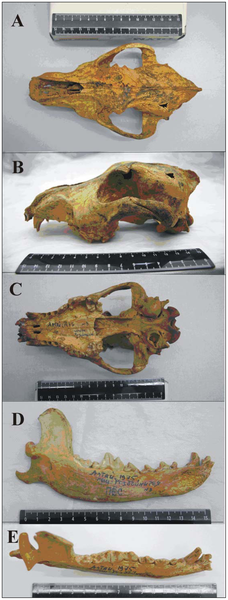Ovodov, N. D., Crockford, S. J., Kuzmin, Y. V., Higham, T. F., Hodgins, G. W., & van der Plicht, J. (2011). A 33,000-year-old incipient dog from the Altai Mountains of Siberia: Evidence of the earliest domestication disrupted by the Last Glacial Maximum. PLoS One, 6(7), e22821.
Background
Virtually all well-documented remains of early domestic dog (Canis familiaris) come from the late Glacial and early Holocene periods (ca. 14,000–9000 calendar years ago, cal BP), with few putative dogs found prior to the Last Glacial Maximum (LGM, ca. 26,500–19,000 cal BP). The dearth of pre-LGM dog-like canids and incomplete state of their preservation has until now prevented an understanding of the morphological features of transitional forms between wild wolves and domesticated dogs in temporal perspective.

Methodology/Principal Finding
We describe the well-preserved remains of a dog-like canid from the Razboinichya Cave (Altai Mountains of southern Siberia). Because of the extraordinary preservation of the material, including skull, mandibles (both sides) and teeth, it was possible to conduct a complete morphological description and comparison with representative examples of pre-LGM wild wolves, modern wolves, prehistoric domesticated dogs, and early dog-like canids, using morphological criteria to distinguish between wolves and dogs. It was found that the Razboinichya Cave individual is most similar to fully domesticated dogs from Greenland (about 1000 years old), and unlike ancient and modern wolves, and putative dogs from Eliseevichi I site in central Russia. Direct AMS radiocarbon dating of the skull and mandible of the Razboinichya canid conducted in three independent laboratories resulted in highly compatible ages, with average value of ca. 33,000 cal BP.
Background
Virtually all well-documented remains of early domestic dog (Canis familiaris) come from the late Glacial and early Holocene periods (ca. 14,000–9000 calendar years ago, cal BP), with few putative dogs found prior to the Last Glacial Maximum (LGM, ca. 26,500–19,000 cal BP). The dearth of pre-LGM dog-like canids and incomplete state of their preservation has until now prevented an understanding of the morphological features of transitional forms between wild wolves and domesticated dogs in temporal perspective.
Methodology/Principal Finding
We describe the well-preserved remains of a dog-like canid from the Razboinichya Cave (Altai Mountains of southern Siberia). Because of the extraordinary preservation of the material, including skull, mandibles (both sides) and teeth, it was possible to conduct a complete morphological description and comparison with representative examples of pre-LGM wild wolves, modern wolves, prehistoric domesticated dogs, and early dog-like canids, using morphological criteria to distinguish between wolves and dogs. It was found that the Razboinichya Cave individual is most similar to fully domesticated dogs from Greenland (about 1000 years old), and unlike ancient and modern wolves, and putative dogs from Eliseevichi I site in central Russia. Direct AMS radiocarbon dating of the skull and mandible of the Razboinichya canid conducted in three independent laboratories resulted in highly compatible ages, with average value of ca. 33,000 cal BP.
Conclusions/Significance
The Razboinichya Cave specimen appears to be an incipient dog that did not give rise to late Glacial – early Holocene lineages and probably represents wolf domestication disrupted by the climatic and cultural changes associated with the LGM. The two earliest incipient dogs from Western Europe (Goyet, Belguim) and Siberia (Razboinichya), separated by thousands of kilometers, show that dog domestication was multiregional, and thus had no single place of origin (as some DNA data have suggested) and subsequent spread.
The Razboinichya Cave specimen appears to be an incipient dog that did not give rise to late Glacial – early Holocene lineages and probably represents wolf domestication disrupted by the climatic and cultural changes associated with the LGM. The two earliest incipient dogs from Western Europe (Goyet, Belguim) and Siberia (Razboinichya), separated by thousands of kilometers, show that dog domestication was multiregional, and thus had no single place of origin (as some DNA data have suggested) and subsequent spread.
No comments:
Post a Comment